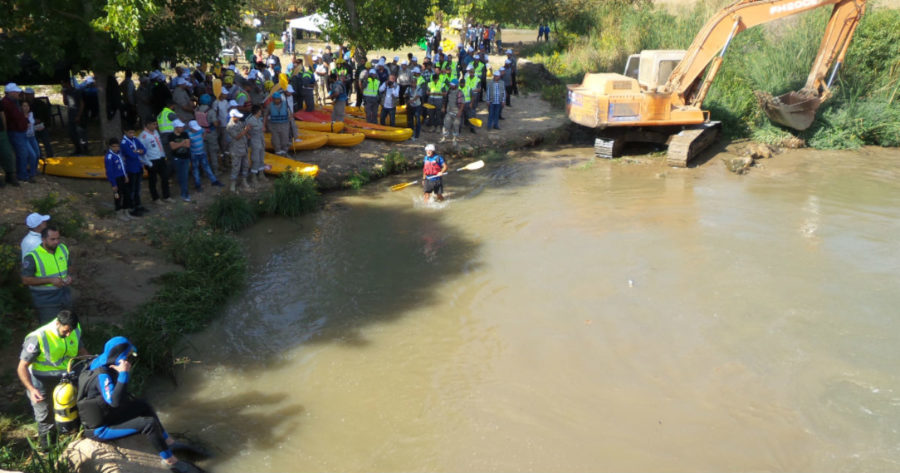
Media silence, governmental neglect, and other deadly emissions intensify as a year passes on failed promises to resolve the Litany pollution while cancer rates continue to rise.
“Let the educational inspection govern instead!” commented a resident of Bar Elias in the Bekaa valey sarcastically. A recent report by the board of educational inspection mandated the closure of two examination centers adjacent to Litani River, and called for the relocation of the students to safer and less hazardous examination centers.
The Inspection’s decision is not the real issue here. However, the real concern is the absence of the government. There is a blatant failure to act shared by the ministry and all concerned authorities in a time when cancer patients are growing by the hundreds. Official response was shy and faded away as soon as the media hiatus around the issue dwindled, and the residents’ protests dispersed.
Read more: Attack on anti-Hezbollah candidate exposes splits among Lebanese Shiites:
A report by “Shu’oon Janoubia” that has kept close observations on the Litani crisis in a recent issue entitled “A National Disaster” claimed that the highest percentage of organic waste found in the river is produced from Zahle and neighboring towns. The majority of these residues originate from the following sources: 13 industrial establishments, 52 dairies and canned good factories (industrial residue and garbage), 8 Hospitals (medical waste), 6 slaughter houses, and 4 restaurants.
The poisonous state of the Litany River, primarily originating from industrial and medicinal waste, caused the people of Bar Elias to launch a movement in June of 2017 entitled “I don’t want to be killed by the Litani”. The movement went on to form a fill that would obstruct the Litani River, adjacent to Zahle’s water treatment plant, as a measurement against the failure of the plant to commence operation according to several governmental pledges.”
This movement, led by the most affected people of Bar Elias, was suspended after a promise made by Prime Minister saad hariri to initiate the water treatment plant and to impose the use of filters on working factories. However, since then a year has passed, and the people of Bar Elias are still awaiting these promises to come to fruition.
Ex-MP Ismail Sukkariye, who is an MD specialized in digestive track diseases, had spoken to “Janoubia” in a recent call and claimed that Cancer occurances have triples and quadrupled in the towns on both banks of the Litany River. He specified, as well, that these incidences of the disease are predominantly occurring in the stomach, followed by colon as well as bladder cancer.
Dr. Sukkariye recently conducted a study on the correlation between Litani pollution and the increased rates of cancer occurring in that region in collaboration with the American University of Beirut, the Lebanese University, and the National Health Council. In an interview with Janoubia, he revealed that the chemicals dumped into the river, whether by hospitals, factories, or plants; along with Nitrates from agricultural pesticides are the main causes for cancer.
It appears, going back the educational inspection, that the decision to relocate students to safer examination centers is a true signal of crisis. There is a real state of emergency threatening the everyday health of the homes situated around the Litany River!
Regarding educational facilities, on the banks of the Litany lies 8 public and private schools. The number of students in these facilities is estimated at around 4000 where some of these schools are open for student at 2 shifts. The summer of 2017 has also recorded one verified death of a female student attending one of these schools according to Janoubia sources.
The same sources, who have supported the relocating decision, have also expressed their concern over the safety of students during the other 9 months of school. “How are they supposed to manage being exposed to putrid fumes in their classrooms and playgrounds 9 months a year?” “The problem isn’t limited to sewage water. Waste products from factories and hospitals are expelled into the river starting from the spring and downstream into the sea.”
The sources remarked that the towns of Bar Elias and Marj are the most effected by the crisis due to their low sea level altitude. However, concerning the protests they have initiated they explained: “We started a lot of movements last year that included “Cry of a child” as well as constant protests, but the fact remains that the government does not care and never responds to our pleas. They simply do not follow up on the crisis management projects recommended by specialized authorities.” “Prime Minister Saad Al-Hariri had vowed to follow this issue personally. However, the treatment facilities are still not working at the required efficiency, and the factory owners responsibly for the majority of the pollution continue to use their political influence to neglect their responsibility and fail to comply with governmental orders.”
The sources concluded by saying: “Today our objections aren’t raised against the decision of the inspection! On the contrary, we are raising our voice for this decision to be a firm stance and a first step towards a permanent solution to the cancer that is slaughtering us!”

